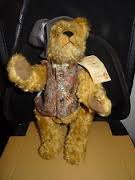
The Brothers Hermann and Their Teddy Bears
The Hermann story began in 1907 in Neufang located between the Thuringian Forest and Sonneberg, Germany, the center of the world’s toy industry at that time. There Johann Hermann made wooden toys and miniature fiddles, passing the knowledge on to his six sons. Johann’s sons went on to go into the teddy bear and soft toy industry, two of them making a name for themselves. And thus began the Hermann dynasty.
Johann’s sons Arthur and Max and his daughter Adelheid went into the teddy bear business in Neufang in 1913 under the name of Johann Hermann Toy Factory. After Johann’s death in 1919, Max and Arthur started their own teddy bear companies. And while Arthur and Adelheid were involved with the teddy bear industry to varying degrees, it was Max, and his older brother Bernhard, who went into the teddy bear manufacturing business in a big way.
Hermann-Spielwaren GmbH
Max first started his company in Neufang, but moved it to Sonneberg three years later under the name Max Hermann Sonneberg. Early Max Hermann teddy bears had inset muzzles and clipped mohair plush in a different color, large ears, and shield-shaped noses with inverted “Y” mouths. The bears had long arms with spoon-shaped paws and little feet, and beginning in the 1930’s carried a circular tag with a running teddy and a dog on a green triangle that remains the family’s logo today.
Max Hermann’s teddy bear company survived World War I, but then came World War II and disaster. For Sonneberg ended up being in the Russian Occupied Zone after the war, a Zone which later became the German Democratic Republic (GDR).
Max, not liking what he saw, sent his son Rolf-Gerhard across the border to the nearby town of Coburg, Bavaria, in the U.S. Zone in 1949. Continuing the family business, Rolf-Gerhard founded the company Hermann & Co. Max and his family finally fled from the GDR to Coburg in 1953, relocating Max Hermann Sonneberg there. When Max died in 1955, his son Rolf-Gerhard took over his father’s firm, which changed its name to Hermann-Spielwaren GmbH in 1979.
Hermann-Spielwaren, and its teddy bears, is still alive today as a family business (Rolf-Gerhard’s children are in charge of the company), plus they have added teddy bear figurines to their line of teddies.
Gebruder Hermann KG
Johann’s eldest son Bernhard moved to Sonneberg with his wife Ida and began making teddy bears and other soft toys in 1912 under the label BE-HA, the pronunciation of the first two letters of Bernhard’s first and last names.
Things were going well until the onset of World War I when Bernhard’s absence due to military service and the lack of skilled labor and materials created many challenges for Ida who was left to run the plant. The company, survived, however, but continued to face a shortage of materials and the effects of hyperinflation after the war ended.
But Bernhard persisted, focusing most of his energy on producing teddy bears and BE-HA grew, in part due to Bernhard’s insistence on top quality and workmanship. BE-HA’s teddy bears in the 1920’s had rounder faces than many of the other German teddy bears, plus had inset contrasting muzzles in clipped mohair.
After World War II Bernhard, like Max, didn’t like what he saw going on in in his part of Germany, so in 1948 he decided to move his company from Sonneberg in the Russian Zone to Hirschaid in the U.S. Zone; the move was completed several years later, in 1953. There he changed the company’s name to Gebruder Hermann KG and started using a red tag to identify his bears which read “HERMANN Teddy ORIGINAL”, a seal which is still used today.
The company continued to grow and develop other plush toys in addition to teddy bears. But the bears remained popular with collectors, so popular that in the 1980’s the Gebruder Hermann Fan Club was formed. But then came competition from the Far East and pressure to lower prices, so in order to keep the prices on its children’s teddies, the company introduced its Hermann Teddy 2000 line in 2000 with the bears being made in East Asia. Today Bernhard’s granddaughters run Gebruder Hermann and the company is still going strong; it celebrated its 100th birthday in 2012.
